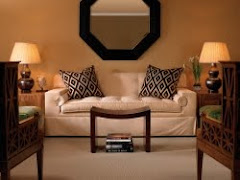Good lighting can alter the apparent size of a room, enhance good features, diminish unattractive ones, and add glamour, drama or the warm glow of tranquility at the turn of a dimmer switch. Lighting is one of the most essential elements to the good design of a room, yet it is usually given the least amount of thought, often being overlooked entirely. How often do people not even bother about the light factor in a room, or wonder how they should control, filter, or enhance light until long after the decorating is underway? If only they had thought about lighting sooner, it might have been possible to install a useful and flexible system for comparatively little expense. Well, it is never too late to start making small changes to accomplish the right lighting for your home. First, consider the natural light in your rooms. Natural light is based on the amount of windows in a room, the position of the house and time of day. During each phase of the day, the interior of a room will look subtly different. So at some point during the day and night most rooms will need the boost of artificial lighting for both practical purposes as well as to create the right mood.
Room lighting can be divided into three distinct types:
General or background lighting
Local or task lighting
Accent or decorative lighting
Ideally, every room should have a combination, depending upon function, of at least two of these types. Ideally, too, each should meld into the other to form a sometimes dramatic but always harmonious whole.
In order to achieve this kind of lighting harmony, it might help to remember that artificial light is, after all, a substitute for daylight which is never static but always shifting and flowing. Think too, of the three types of light as representing different moods of daylight and how similar effects can be created.
In living rooms, the best effect is achieved if all three types of light are used.
Background lighting will seem more subtle if it comes from well-placed wall lights, used on their own or in conjunction with up-lights set on the floor and concealed behind plants or furniture, or in urns. Up-lights incidentally, preferably with dimmer switches, provide the best way of making dramatic room changes when it is impossible to change the overall wiring, or to put in more outlets. This kind of lighting will give a soft wash of light as opposed to the bland light that comes from a central ceiling fixture. To continue the analogy of daylight: the sun is never static in the middle of the sky, except, momentarily, during midday. So why should we try to emulate that harsh midday glare?
Task or local lighting is provided by table lamps and floor lamps placed by the side of sofas and armchairs for comfortable reading, or by angled wall lamps set just above seating areas if there is not very much floor space, and, of course, by desk lamps for writing and working.
Accent or decorative lighting comes from eyeball or different spots of various types, inset into the ceiling if at all possible, or in some way angled to highlight paintings, objects, tabletops, and so on. It can also come from pools of light cast by table lamps, from concealed lights in bookshelves and display cabinets, up-lights in floors, and from candles.
One important point to remember, if you do have the chance to rewire a room, is that all these light fixtures can be controlled and subtly modulated by separate switches and/or dimmer switches set by the door. If you are using up-lights positioned on the floor, remember to ask your electrician to have them switched from the door, for this will save a great deal of irritating stooping and crawling around on the floor to switch them on and off. Alternatively, if the rewiring involved to locate the switches by the door is too complicated, ask your electrician to install kick switches by any floor lamps, so that you can control them without having to bend.
Visit my blog over the next few days to discover the factors to consider for each room in your home...










No comments:
Post a Comment